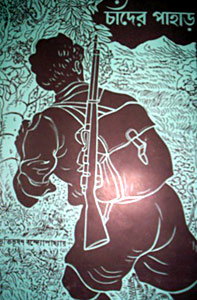Based on the backdrop of early 20th century, Chander Pahar depicts completely an adventure story. In the cape of an adventure chronicle, Chander Pahar represents the dangerous scenario before the World War first and the aspirations of the youngsters for a serene world. In the social drabness of the period, Chander Pahar delineates the yearning of an individual for adventure in the wild lands and forests. Idolized by the famous explorers like, Livingstone, Marco Polo and Mungo Park, he aspires to follow the footsteps of these famous personalities and to explore a new world. Chander Pahar, considered to be one of the famous adventure novels in Bengali, actually signifies the adventure of dream- a dream of an adolescent mind.
Author:
Bibhutibhusan Bandopadhya, one of the famous stalwarts of the Bengali Literature. Psycho-anatomy being his key subject, his novels are always the piercing analysis of human conditions. Born in 20th September 1894 in 24 Parganas of West Bengal, Bibhutibhusan was a sensitive observer of the situations and conditions of the individual in the contemporary society. He was proficient enough to depict the adolescent psychology and their adventurous delusion to achieve the target, which was also illusory like their delusion.
Synopsis:
 Based on the background of Pre world war in 1909-10, Chander Pahar is the story of a young Bengali man, adventuring in the forests of Africa. Adolescent psychology represented by Shankar is the protagonist in the novel. Shankar, a 20-year-old man, recently graduated from college yarns for adventure in his dreams. He was about to get job in a jute mill, the prospect, which he ardently abhors. He dreamt of the famous explorers including Marco Polo, Livingstone, Mungo Park etc. and wanted to be the explorers like them. Eventually, by a stroke of luck he got a job as a clerk in Uganda Railways and thus his dream comes true to get rid of the loathesome job in the jute industry. Finally becoming a station master in Africa, Shankar experiences all the precarious events take place during his days in Africa. He encounters the hazardous situations with the man-eating lions and the venomous black mambo till he met a middle aged Portuguese explorer and a gold prospector Diego Alvarez. The story line of Chander Pahar develops when Shankar was deeply enthused by Alvarez, who told him the story of his early life as an explorer. The adventure story of Alvarez and his friend Jim Carter braved mountains of Richsterveldt to find the largest diamond mine, deeply moved Shankar. However they were thwarted by the Bunip, a legendary monster, who guards the mines and it ultimately killed Carter, Alvarez`s companion.
Based on the background of Pre world war in 1909-10, Chander Pahar is the story of a young Bengali man, adventuring in the forests of Africa. Adolescent psychology represented by Shankar is the protagonist in the novel. Shankar, a 20-year-old man, recently graduated from college yarns for adventure in his dreams. He was about to get job in a jute mill, the prospect, which he ardently abhors. He dreamt of the famous explorers including Marco Polo, Livingstone, Mungo Park etc. and wanted to be the explorers like them. Eventually, by a stroke of luck he got a job as a clerk in Uganda Railways and thus his dream comes true to get rid of the loathesome job in the jute industry. Finally becoming a station master in Africa, Shankar experiences all the precarious events take place during his days in Africa. He encounters the hazardous situations with the man-eating lions and the venomous black mambo till he met a middle aged Portuguese explorer and a gold prospector Diego Alvarez. The story line of Chander Pahar develops when Shankar was deeply enthused by Alvarez, who told him the story of his early life as an explorer. The adventure story of Alvarez and his friend Jim Carter braved mountains of Richsterveldt to find the largest diamond mine, deeply moved Shankar. However they were thwarted by the Bunip, a legendary monster, who guards the mines and it ultimately killed Carter, Alvarez`s companion.
Resigned from the job Shankar decided to venture out with Alvarez in the quest of diamond mine again. Encountering with a number of hazards, the raging volcano being the greatest challenge, Shankar finally discovered the mines. But that legendary monster killed Alvarez in the same way, it killed Carter. Shankar entrapped inside sets out to discover the Bunip`s cave and find out the diamond mines accidentally. He strives to reach the civilization and ultimately with great difficulty he gets out marking his way with "pebbles" and taking some back with him, not knowing each is a piece of uncut diamond. The story ends with Shankar`s return to the fold of civilization.
Chander Pahar is the story of pubescent adventure infested with the thrilling excitement and pleasure to unveil the unknown. The title "Chander Pahar" cues the significant spirit of the novel. Chander Pahar itself symbolizes the unknown abstraction and through the portraiture of Shankar, Bibhutibhusan depicts the adolescent psychology, craving to unveil the mystery or to know the unknown. Chander Pahar, is an intuitive study of adolescent psychology as its title suggests and a successful presentation of psycho-anatomy of a growing youth.













